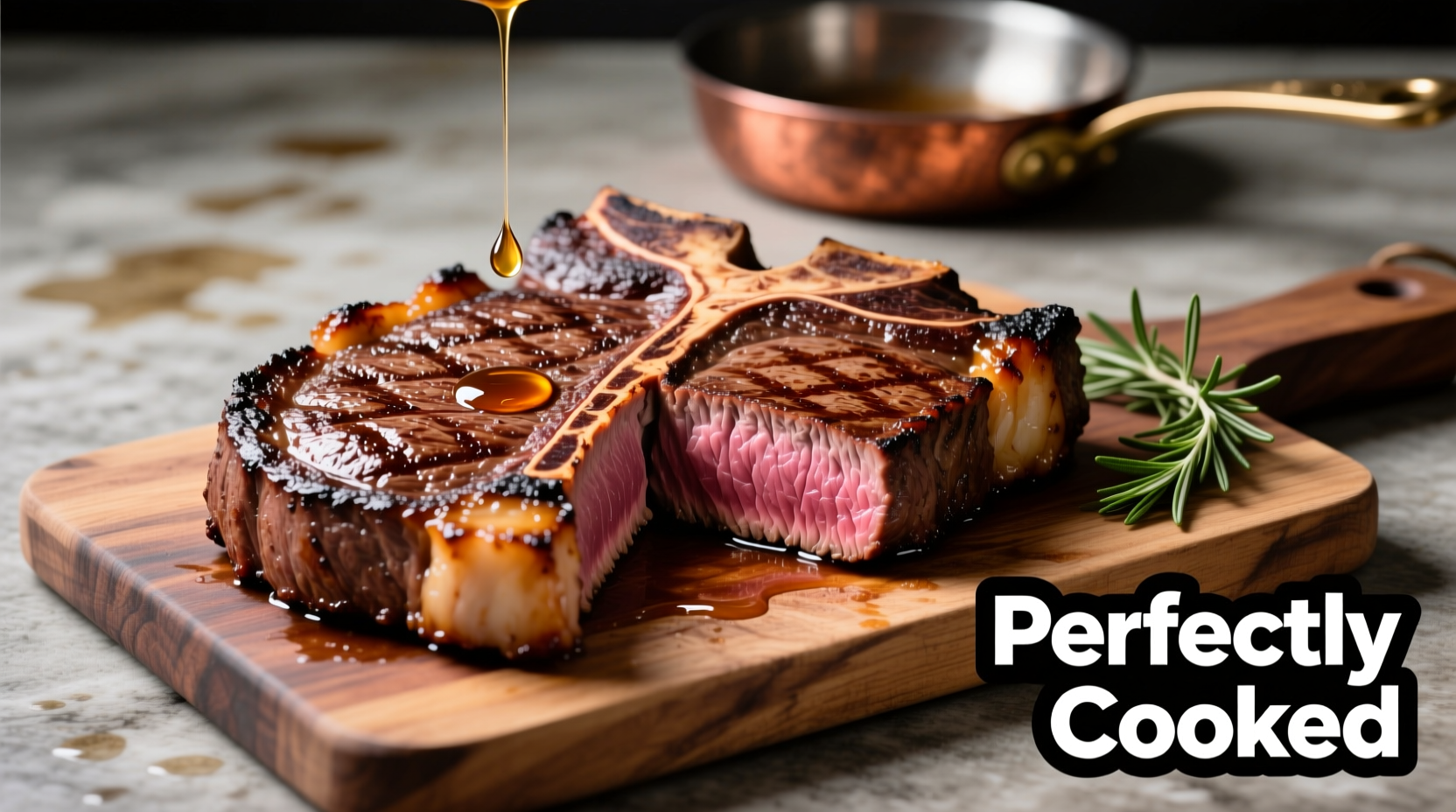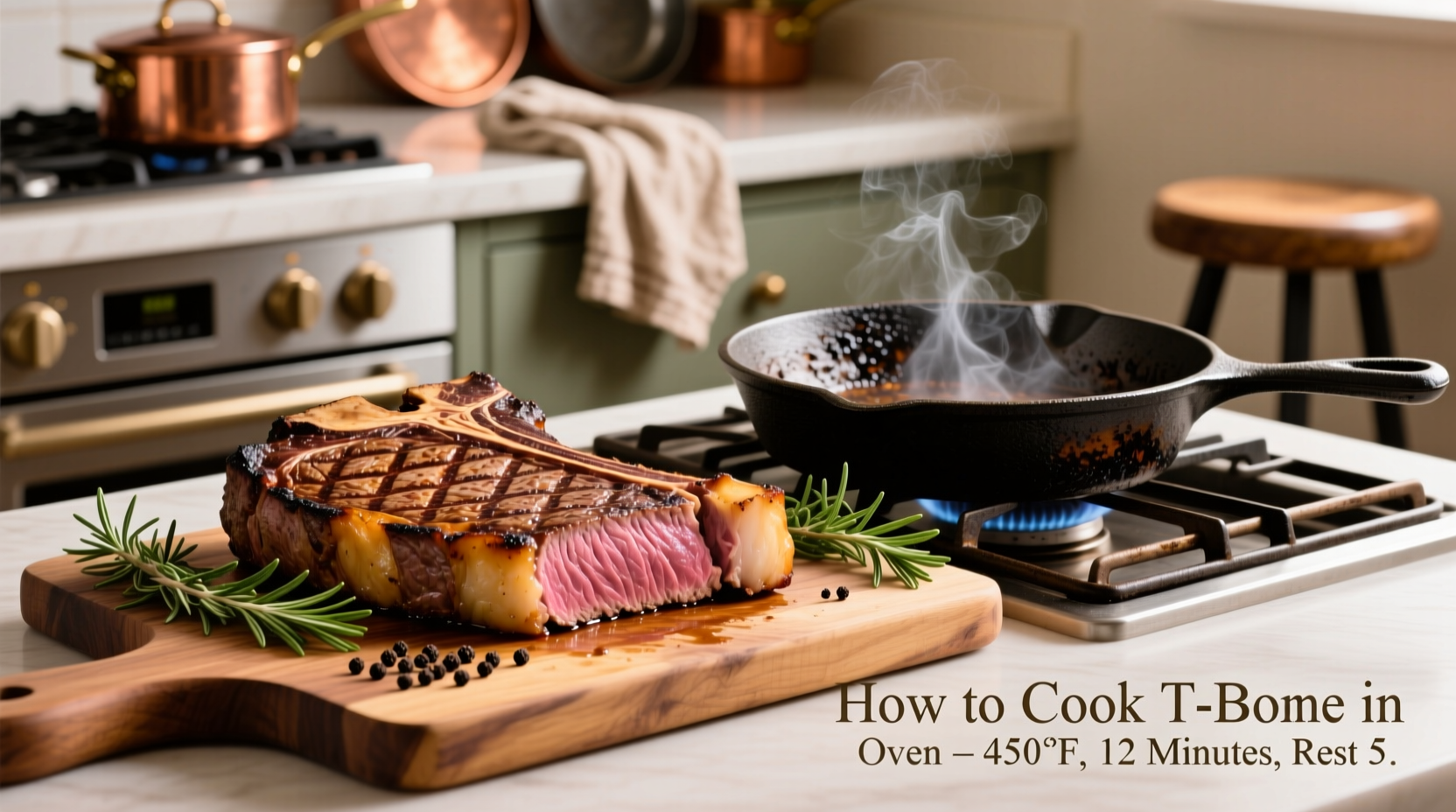Master Oven-Cooked T-Bone Steak: No Grill Required
Want restaurant-quality T-bone steak without firing up the grill? You're in the right place. This comprehensive guide delivers the precise oven method professional chefs use to achieve perfectly cooked T-bone steak with a flavorful crust and juicy interior. Whether you're cooking for a special occasion or craving a steakhouse experience at home, these field-tested techniques guarantee results every time.
Why Oven Cooking Beats Grill Anxiety
While grilling remains popular, oven cooking offers critical advantages for T-bone preparation. Unlike outdoor grilling where temperature fluctuations and flare-ups can ruin your steak, the oven provides consistent, controllable heat. This precision matters because T-bone steaks contain two distinct muscles (filet mignon and strip steak) that require careful temperature management. According to the USDA Food Safety and Inspection Service, proper internal temperature control prevents both undercooked safety risks and overcooked disappointment.
Your Essential T-Bone Toolkit
- 1.5-inch thick T-bone steak (minimum 24-32oz)
- Heavy cast-iron or oven-safe skillet
- Oven thermometer (critical for accuracy)
- Instant-read meat thermometer
- High smoke-point oil (avocado or grapeseed)
- Kosher salt and freshly ground black pepper
Step-by-Step Cooking Process
Preparation: The 40-Minute Secret
Remove steak from refrigerator 40 minutes before cooking. This critical step allows the meat to reach room temperature, ensuring even cooking. Pat thoroughly dry with paper towels - moisture is the enemy of proper searing. Season generously with kosher salt (1 teaspoon per pound) and freshly ground black pepper on all surfaces.
Searing: Building Flavor Foundation
Preheat oven to 400°F (204°C). Heat cast-iron skillet over medium-high until smoking hot (about 5 minutes). Add 1 tablespoon oil, then carefully place steak in skillet. Press gently with tongs for full contact. Sear undisturbed for 2-3 minutes until deep brown crust forms. Flip and sear opposite side for another 2-3 minutes. For maximum flavor development, sear the edges for 30 seconds each using tongs.
| Doneness Level | Oven Time (8-12 min) | Internal Temp | Resting Temp Rise |
|---|---|---|---|
| Medium-Rare | 8-9 minutes | 120-125°F | +5°F |
| Medium | 10-11 minutes | 130-135°F | +5°F |
| Medium-Well | 12-14 minutes | 140-145°F | +5°F |
Oven Finish: Precision Temperature Control
Transfer skillet directly to preheated oven. Insert oven-safe thermometer into thickest part of the strip section (avoiding bone). For medium-rare, cook until thermometer reads 120-125°F (8-9 minutes). Remember that temperature will rise 5°F during resting. The Rutgers Food Science Department confirms this carryover cooking phenomenon occurs in all thick-cut meats due to residual heat conduction.
Resting: The Non-Negotiable Step
Transfer steak to cutting board, tent loosely with foil, and rest for 10 minutes. This allows juices to redistribute throughout the meat. Cutting too soon releases precious juices onto your plate rather than staying in the steak. During this critical phase, the internal temperature will rise to the perfect medium-rare (125-130°F).
Serving: Maximizing Your Effort
Slice against the grain perpendicular to the bone. Serve immediately with a final sprinkle of flaky sea salt. For best results, pair with simple sides that won't compete with your perfectly cooked steak - roasted vegetables or a crisp salad work beautifully.
Avoid These 3 Common T-Bone Mistakes
- Skipping the dry step: Moisture prevents proper Maillard reaction. Pat steak dry thoroughly before seasoning.
- Overcrowding the pan: Only cook one steak at a time to maintain proper searing temperature.
- Cutting too soon: Resting for 10 minutes is essential for juicy results - don't skip this critical step.

When Oven Cooking Shines Over Grilling
While grilling offers classic flavor, oven cooking provides distinct advantages in specific scenarios. During winter months or rainy weather, the oven delivers consistent results without weather interference. For thicker cuts (over 1.5 inches), the oven's even heat prevents exterior burning before interior reaches proper temperature. Additionally, indoor cooking avoids smoke alarms and provides better temperature control for beginners. Professional chefs often use this oven-sear method for premium cuts like T-bone because it maximizes moisture retention while developing complex flavor compounds through controlled Maillard reaction.
Frequently Asked Questions
Can I cook frozen T-bone steak in the oven?
No, cooking frozen T-bone steak produces uneven results. The exterior overcooks while the interior thaws. Always thaw steak in the refrigerator for 24 hours before cooking. The USDA Food Safety and Inspection Service confirms that proper thawing prevents dangerous temperature zones where bacteria can multiply.
What's the ideal thickness for oven-cooked T-bone?
Choose T-bone steaks at least 1.5 inches thick. Thinner cuts overcook during the necessary searing phase. The thicker profile allows proper crust development while maintaining a juicy interior. Most high-end butcher shops and specialty markets carry premium 1.5-2 inch thick T-bones specifically for oven or grill cooking.
Should I add butter during oven cooking?
Add 2 tablespoons of butter, garlic, and fresh herbs during the last 2 minutes of searing. Tilt the pan and spoon the melted butter continuously over the steak (basting) to enhance flavor and create a luxurious finish. This technique, used in professional kitchens, infuses additional flavor without compromising the essential sear.
How do I fix an undercooked T-bone?
Return the steak to the hot skillet over medium heat for 60-90 seconds per side. Monitor internal temperature closely with an instant-read thermometer. Never microwave undercooked steak as it creates uneven texture. The American Meat Science Association recommends gradual temperature correction to maintain meat integrity.











 浙公网安备
33010002000092号
浙公网安备
33010002000092号 浙B2-20120091-4
浙B2-20120091-4